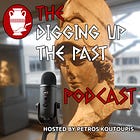Featured Episode - The Might and Influence of the Neo-Assyrians
Issue 47

In This Episode
In this episode, host, Petros Koutoupis, sits down with British Assyriologist and ancient Near Eastern scholar, Dr. Stephanie Dalley, to discuss the ancient Neo-Assyrians of Iron Age Mesopotamia. Who were the Neo-Assyrians and how did they influence the ancient Near Eastern world? How did they rise to power and under what circumstances did their empire fall? Also discussed is the location of the Hanging Gardens. Was it in Babylon or did it exist further north in Assyria? Tune in for the answers and more.
You can listen to this episode on:
Glossary
Akkadian - An East Semitic language spoken by an early Mesopotamian civilization starting around 2500 BCE.
Ashurbanipal - King of the Neo-Assyrian Empire who reigned from 669 BCE to his death in 631 BCE.
Cuneiform - A wedge-shaped logo-syllabic script used to write several languages of the Ancient Middle East.
Elam - An ancient civilization located in western Iran. The Elamites emerged as early as the end of the 4th millennium BCE and continued to occupy the region until at last the middle of the 1st millennium BCE.
Harran - Located in southeastern Turkey, the ancient city of Harran came under Assyrian rule by the end of the 14th century BCE.
Iron Age - Defines a historic period which started at approximately between 1200 BCE in the eastern Mediterranean. It is characterized by the use of iron and the appearance of new civilizations.
Mesopotamia - A region of Western Asia situated between the Tigris and Euphrates rivers in what is today Iraq.
Neo-Assyrian - An ancient Mesopotamian civilization (ca. 911 - 609 BCE) originating from northern Mesopotamia and extending their empire across the entire Near East.
Neo-Babylonian - An ancient Mesopotamian civilization (ca. 626 - 539 BCE) originating from southern Mesopotamia and extending their empire across the entire Near East.
Nimrud - Former Neo-Assyrian capital and ancient city located in northern Iraq.
Nineveh - An ancient Assyrian city of Upper Mesopotamia, located in the modern-day city of Mosul in northern Iraq.
Sumer - The earliest known civilization in the region of southern Mesopotamia (south-central Iraq).
Urartu - A first millennium BCE kingdom located in the Armenian highlands and to the North of Assyria. The Biblical Ararat.
Uruk - An ancient city of Sumer situated east of the present bed of the Euphrates River.
Recommended Books
Myths from Mesopotamia: Creation, the Flood, Gilgamesh, and Others
By Stephanie Dalley
The ancient civilization of Mesopotamia thrived between the rivers Tigris and Euphrates over 4,000 years ago. The myths collected here, originally written in cuneiform on clay tablets, include parallels with the biblical stories of the Creation and the Flood, and the famous Epic of Gilgamesh, the tale of a man of great strength, whose heroic quest for immortality is dashed through one moment of weakness.
The City of Babylon
By Stephanie Dalley
The 2000-year story of Babylon sees it moving from a city-state to the centre of a great empire of the ancient world. It remained a centre of kingship under the empires of Assyria, Nebuchadnezzar, Darius, Alexander the Great, the Seleucids and the Parthians. Its city walls were declared to be a Wonder of the World while its ziggurat won fame as the Tower of Babel. Visitors to Berlin can admire its Ishtar Gate, and the supposed location of its elusive Hanging Garden is explained. Worship of its patron god Marduk spread widely while its well-trained scholars communicated legal, administrative and literary works throughout the ancient world, some of which provide a backdrop to Old Testament and Hittite texts. Its science also laid the foundations for Greek and Arab astronomy through a millennium of continuous astronomical observations. This accessible and up-to-date account is by one of the world's leading authorities.
The Mystery of the Hanging Garden of Babylon: An Elusive World Wonder Traced
By Stephanie Dalley
In this remarkable volume Stephanie Dalley, a world expert on ancient Babylonian language, exposes new evidence and clarifies all the known material about this enigmatic World Wonder. Placing the Garden within a tradition of royal patronage, Dalley describes how the decipherment of an original text and its link to sculpture in the British Museum has enabled her to pin down where and by which king the Garden was laid out, and to describe in detail what it looked like. Through this dramatic and fascinating reconstruction of the Garden, Dalley also follows its influence on later garden design.








